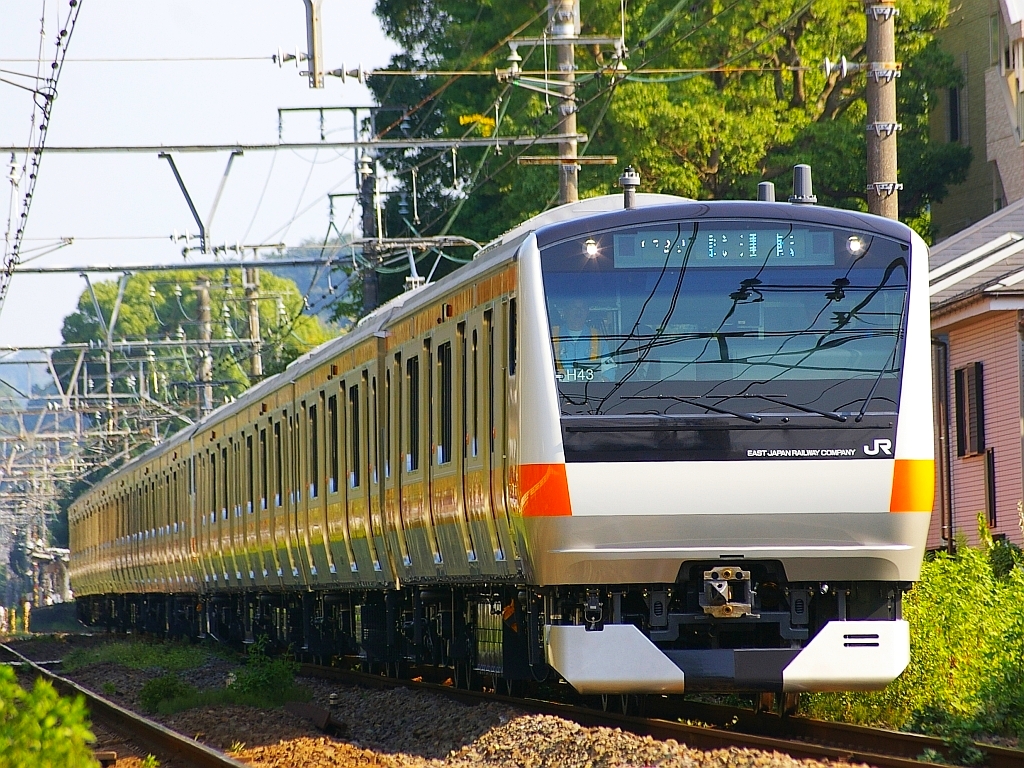- E233 series
Infobox EMU
name = E233 series
imagesize = 240px
caption = First official test run of the E233 series, onSeptember 21 2006
InService = 2006 - Present
Manufacturer = JR East, Kawasaki Heavy Industries, Tokyu Car
Family =
Built =
Refurbishment =
Formation = 4/5/6/10 cars per trainset
Operator =JR East
Depots = Toyoda, Urawa, Kōzu
LinesServed =Chūō Main Line ,Keihin-Tōhoku Line
CarBody = Stainless steel
CarLength = 20,000 mm
CarWidth = 2,950 mm
CarHeight =
MaxSpeed = 120 km/h
Weight =
Capacity =
Acceleration = 3.0 km/h/s
Deceleration = 5.2 km/h/s (emergency braking)
Traction =
Power =
Gauge = 1,067 mm
Voltage = 1,500 V DC overhead
Brakes =
SafetySystem = ATS-P, ATS-SN, ATC, Digital ATCThe E233 series is a commuter and suburban EMU type developed by
East Japan Railway Company (JR East) from the earlierE231 series design. The first train was introduced in December 2006 for use on theChūō Main Line , followed by the E233-1000 series variant in 2007 for use on the Keihin-Tōhoku and Negishi lines, and the E233-3000 series outer-suburban variant in December 2007 for use on theTōkaidō Main Line . A narrow-bodied variant will be introduced onJōban Line andTokyo Metro Chiyoda Line inter-running services from summer 2008. [http://www.jreast.co.jp/press/2006_2/20070303.pdf]Design details
The E233 series, according to the October 2005 press release, features two identical sets of the main equipment in case of failure. This is the first JR East stock to feature such backup measures.
The E233 series provides for better accessibility for the disabled, and is designed to be more comfortable to ride overall than conventional stock. The height between the platform and the train was reduced from the 80 mm of the 201 and 209 series to 30 mm. Seats are 460 mm wide, compared to the 430 mm of the 201 series and 450 mm of the 209 series. For standing passengers the handle straps have been lowered with 50 mm compared to older train models.
This stock also features an air filtration system to remove unpleasant smells. It also features
liquid crystal display information screens and automatic announcement system similar to those currently deployed on theE231 series rolling stock on theYamanote Line .The stock is the first JR East stock to use full-colour LEDs for the destination indicators on the sides of the carriages. This is due to the fact that the Chūō line has numerous types of services, and colour-coding will help passengers board the correct train.
Variants
Chūō Line E233-0
The first train was introduced in December 2006 for use on the
Chūō Main Line , Ōme, and Itsukaichi lines, replacing the aging201 series trains. The entire fleet of 688 E233 series vehicles (10-car x 42, 6-car x 28, 4-car x 25) was delivered by the end of March 2008. ["Tetsudō Daiya Jōhō" magazine May 2008 issue, p53] 4+6-car sets are used on the Ōme Line and Itsukaichi Line.Keihin-Tōhoku Line E233-1000
JR East announced in September 2006 that a fleet of 83 10-car E233 series sets would also be introduced on the Keihin-Tōhoku and Negishi lines from autumn 2007, replacing the
209 series EMUs currently used. The first set was delivered in August 2007. The main difference over the earlier E233-0 is the absence of passenger door controls.The first set was scheduled to enter service on
22 December 2007 . [ http://rail.hobidas.com/comm/info/archives/2007/12/jre2331000.html Rail Hobidas.com "Keihin-Tōhoku Line E233-1000 series enter service" (5 December 2007 )] Twelve sets are due to be in operation by the end of fiscal 2007. ["Japan Railfan Magazine" March 2008 issue, p52]Jōban Line E233-2000
A new narrow-bodied variant was scheduled to be introduced on
Jōban Line andTokyo Metro Chiyoda Line inter-running services from summer 2008, replacing the203 series and207 series EMUs currently used. ["Japan Railfan Magazine" March 2008 issue, p73] Delivery of the first train has now been rescheduled to May 2009.Tōkaidō Main Line E233-3000
A single 10+5-car E233-3000 series outer suburban set (E01 + E51) for use on the
Tōkaidō Main Line was delivered to Kōzu Depot in November 2007. This includes two bilevel Green cars. ["Tetsudō Daiya Jōhō" magazine January 2008 issue] The set entered revenue service on10 March 2008 . It is limited to use on the Tōkaidō Main Line between Tokyo and Atami. [http://railf.jp/news/?03110700 "Japan Railfan Magazine" (accessed11 March 2008 )]External links
* [http://www.jreast.co.jp/press/2005_2/20051001.pdf Chūō Line press release]
* [http://www.jreast.co.jp/press/2006_1/20060901.pdf Keihin-Tōhoku Line press release]
* [http://www.jreast.co.jp/press/2006_2/20070303.pdf Jōban Line press release]References
Wikimedia Foundation. 2010.
